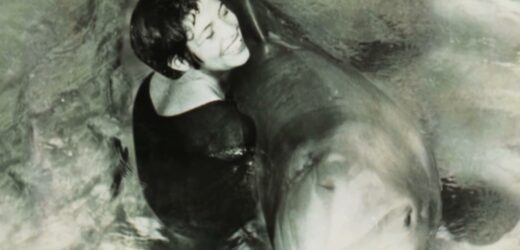PETER the dolphin fell in love with a human woman – but when the two separated he was so heartbroken he took his own life.
The six-year-old bottlenose dolphin had a romance with 23-year-old research assistant Margaret Howe during a wild ten week fling in the 1960s.
But when they were pulled apart by circumstances, Peter was left utterly devastated.
He refused to breathe, sank to the bottom of his tank, and died in a case widely claimed to be an act of "suicide".
Margaret and Peter first met in a bizarre NASA-funded experiment designed to teach dolphins to understand and potentially even mimic human speech.
The purpose the test was stranger still – with the longtime goal being to work out how humans could talk to aliens.
And perhaps even odder was the massive undertaking to create the "The Dolphin House" – a sprawling complex flooded with water where Margaret and Peter would live together for ten weeks.
Margaret would spend all her time in the 22inches deep seawater with Peter – apart from when she could climb onto a dry bed or desk which hung from the ceiling hidden behind shower curtains.
The couple were to live, sleep, wash, eat and play together with the as they attempted to teach the dolphin – one of the most intelligent animals on the planet – how to speak through his blowhole.
Dr John C Lilly from the Dolphin Point Laboratory on the island of St Thomas in the Caribbean oversaw the experiment – and he predicted the dolphin could be able to mimic human speech "within a decade or two".
However, between the dolphin and his human handler things became much more complicated than anyone could have predicted.
His own vet described Peter as falling "madly in love" with Margaret.
While the test was unsuccessful in getting a dolphin to learn English, it did offer an insight into the powerful emotions held by animals.
Margaret noticed by week four of the experiment Peter had started to become sexually aroused around her and he would be flirtatious – nibbling at her and rubbing against her legs.
And as Peter's urges became more and more lusty, the young researcher decided to start pleasuring the dolphin in a bid to keep him focused.
If life becomes too unbearable, the dolphins just take a breath and they sink to the bottom
She denied this was sexual for her – but acknowledges it was for him – and instead describes the experience as "sensuous".
Margaret however did admit she formed a deep emotional bond with Peter.
"That relationship of having to be together sort of turned into really enjoying being together, and wanting to be together, and missing him when he wasn’t there," she told a BBC documentary in 2014.
"It was just easier to incorporate that and let it happen. It was very precious, it was very gentle.
"Peter knew I was right there, Peter was right there … again it was sexual on his part, it was not sexual on mine — sensuous perhaps.
"It would just become part of what was going on, like an itch, just get rid of that, scratch it and we’ll be done and move on."
Peter was however utterly smitten with Margaret – and he would get jealous if she spoke to other humans and even lost interest in two other female dolphins.
He took to sleeping just next to her suspended bed, the two would watch TV, and he even started to form some human sounds, in particular the word "ball".
However, as their bond became deeper and they established a workable relationship between human and dolphin – the experiment's funding ran out and The Dolphin House had to close.
Peter was shipped away from Margaret – being taken 1,000 miles away to Dr Lilly's other – much smaller – lab in Florida.
Within weeks the seemingly heartbroken dolphin had died in an apparent act of suicide as he was kept in cramped conditions without his "lover".
"I got that phone call from John Lilly. John called me himself to tell me. He said Peter had committed suicide," she told The Guardian.
The lab's vet, Andy Williamson, even attributed his death to a broken heart as he was ripped away from Margaret.
Margaret could rationalize it, but when she left, could Peter? Here’s the love of his life gone
He said: "Margaret could rationalize it, but when she left, could Peter? Here’s the love of his life gone."
Ric O’Barry, from animal rights organisation The Dolphin Project, also backs the description of Peter's death as "suicide".
He said: "Dolphins are not automatic air-breathers like we are. Every breath is a conscious effort.
"If life becomes too unbearable, the dolphins just take a breath and they sink to the bottom.
"They don’t take the next breath."
Scientists are split over whether dolphins have the mental capacity to participate in "suicide" in the human sense of the word.
However, distressed animals are well known to engage in self destructive behavior that may prove fatal – such as the case of Hugo the whale, who rammed his head into his tank so often that he suffered a brain aneurysm.
Lori Marino, a behavioral neuroscientist, dolphin expert and founder of The Kimmela Center for Animal Advocacy, published a paper which argues as much.
She writes that their brains have "sophisticated capacity for emotion and the kinds of thinking processes that would be involved in complex motivational states, such as those that accompany thoughts of suicide".
We pay for your stories!
Do you have a story for The Sun news desk?
Email us at [email protected] or call 02077824104. You can WhatsApp us on 07423 720 250. We pay for videos too. Click here to upload yours
Click here to get The Sun newspaper delivered for FREE for the next six weeks.
Source: Read Full Article






